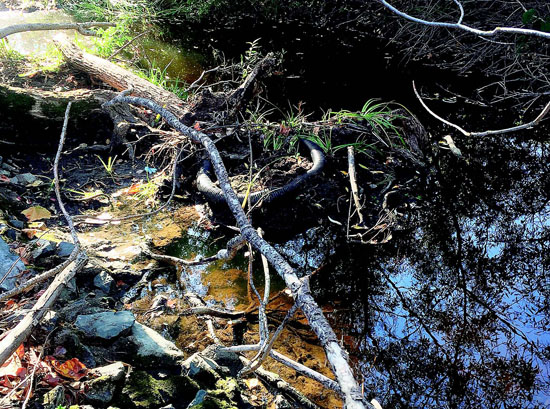|
|
Published November 18th, 2015
|
Is The Town Ready for Winter and Spring Rain?
|
|
| By Sophie Braccini |
 |
| Moraga Creek cluttered with debris Photo Sophie Braccini |
The latest data on El Niño continue to show it is still on track to be the strongest in recorded history, with maximum impact in California expected from January to March. Cities and towns are preparing, checking and repairing their infrastructure, as well as working together to prepare their response to emergency situations.
 As El Niño strengthens, the persistent warmth of the western tropical Pacific Ocean drops. The drop in temperature could finally get the best of the "ridiculously resilient ridge" that diverted winter storms away from California the past three winters, and also lead to the disappearance of "the Blob" - warm water off the Washington and Oregon coastlines - believed to also be a result of the ridge. Floods and landslides are a likely outcome of torrential rains on parched soil by years of drought. "Managing hydrological impacts of simultaneously-occurring record El Niño and record drought in California will be challenging," wrote Daniel Swain, member of Stanford University Climate and Earth System Dynamics Group.
As El Niño strengthens, the persistent warmth of the western tropical Pacific Ocean drops. The drop in temperature could finally get the best of the "ridiculously resilient ridge" that diverted winter storms away from California the past three winters, and also lead to the disappearance of "the Blob" - warm water off the Washington and Oregon coastlines - believed to also be a result of the ridge. Floods and landslides are a likely outcome of torrential rains on parched soil by years of drought. "Managing hydrological impacts of simultaneously-occurring record El Niño and record drought in California will be challenging," wrote Daniel Swain, member of Stanford University Climate and Earth System Dynamics Group.
 "We have or are completing preparation to help Moraga prepare for El Niño this winter and spring," says Moraga Public Works Director Edric Kwan, who notes that his team is inspecting all storm drain inlets and removing debris, clearing out storm drain lines, and repairing storm drain pipelines that are part of this year's paving project.
"We have or are completing preparation to help Moraga prepare for El Niño this winter and spring," says Moraga Public Works Director Edric Kwan, who notes that his team is inspecting all storm drain inlets and removing debris, clearing out storm drain lines, and repairing storm drain pipelines that are part of this year's paving project.
 When Kwan presented the storm drain master plan to the town council this summer he indicated that the weaknesses of the system are the narrow, obstructed or damaged pipes and the under-capacity culverts. The report listed high priority work with an associated cost of $8.9 million.
When Kwan presented the storm drain master plan to the town council this summer he indicated that the weaknesses of the system are the narrow, obstructed or damaged pipes and the under-capacity culverts. The report listed high priority work with an associated cost of $8.9 million.
 The study done by Schaaf and Wheeler listed the 35 culverts analyzed, with 17 undersized. Five of these were a high priority, including those under St. Andrews Drive, Camino Pablo, Woodford Drive and the Hacienda de las Flores property. One solution proposed by the consultant was daylighting or uncovering the culverts. The report also identified several neighborhood drain collectors that did not have the capacity to handle a 10-year flood (see http://www.moraga.ca.us/council/meetings/2015/070815/TC-070815_XI_B_StormDrainMasterPlan.pdf).
The study done by Schaaf and Wheeler listed the 35 culverts analyzed, with 17 undersized. Five of these were a high priority, including those under St. Andrews Drive, Camino Pablo, Woodford Drive and the Hacienda de las Flores property. One solution proposed by the consultant was daylighting or uncovering the culverts. The report also identified several neighborhood drain collectors that did not have the capacity to handle a 10-year flood (see http://www.moraga.ca.us/council/meetings/2015/070815/TC-070815_XI_B_StormDrainMasterPlan.pdf).
 When Kwan presented the storm drain plan to the council, members approved it but recognized that there were no funds for it at that time. They decided that the first tasks were to determine ownership of pipes and culverts, and to conduct a community needs survey, which includes funding of the town's storm drain system needs. Schaaf and Wheeler is contracted to complete the easement research for storm drain pipes and culverts to determine responsibility.
When Kwan presented the storm drain plan to the council, members approved it but recognized that there were no funds for it at that time. They decided that the first tasks were to determine ownership of pipes and culverts, and to conduct a community needs survey, which includes funding of the town's storm drain system needs. Schaaf and Wheeler is contracted to complete the easement research for storm drain pipes and culverts to determine responsibility.
 Storm drain repairs are part of this year's paving program; they include those located on Alderbrook Place, Del Monte Way, Natalie Drive and Scofield Drive. Kwan confirmed that next year's paving program will address locations on Bollinger Canyon Road and Corliss Drive.
Storm drain repairs are part of this year's paving program; they include those located on Alderbrook Place, Del Monte Way, Natalie Drive and Scofield Drive. Kwan confirmed that next year's paving program will address locations on Bollinger Canyon Road and Corliss Drive.
 The study also showed that the creeks that run in daylight have enough capacity, provided that the neighbors do their cleanup work. A simple stroll on the Lafayette-Moraga Regional Trail behind Saklan School raises doubts regarding the cleaning up of at least a portion of the Moraga Creek: tree trunks and debris clutter the stream and branches have started to pile under the Canyon Bridge. "In the case of the creek by the bike trail near School Street, the town is in the process of notifying residents, to reiterate their responsibility of maintaining their creeks as it has been theorized to be an El Niño year," confirmed Kwan.
The study also showed that the creeks that run in daylight have enough capacity, provided that the neighbors do their cleanup work. A simple stroll on the Lafayette-Moraga Regional Trail behind Saklan School raises doubts regarding the cleaning up of at least a portion of the Moraga Creek: tree trunks and debris clutter the stream and branches have started to pile under the Canyon Bridge. "In the case of the creek by the bike trail near School Street, the town is in the process of notifying residents, to reiterate their responsibility of maintaining their creeks as it has been theorized to be an El Niño year," confirmed Kwan.
 "We handed out information on how to prepare for storms at the Community Faire and Pear and Wine Festival and shared information through articles in the Town Crier and About Town," said Kwan, adding that the town did its homework, cleaning rain gutters on all municipal buildings, and delaying the reconstruction of Rheem Boulevard and repair of its underlying slides in order to minimize water erosion.
"We handed out information on how to prepare for storms at the Community Faire and Pear and Wine Festival and shared information through articles in the Town Crier and About Town," said Kwan, adding that the town did its homework, cleaning rain gutters on all municipal buildings, and delaying the reconstruction of Rheem Boulevard and repair of its underlying slides in order to minimize water erosion.
 Lamorinda is also strengthening its capacity to respond to emergencies. "We are working on disaster drills with Lafayette and Orinda to test emergency radio systems," explained Kwan. "We have done extensive emergency preparedness training with Saint Mary's College and Moraga-Orinda Fire District for all the staff and town council over the past three years, and coordinated training efforts with Orinda and Lafayette last year." The town also completed a Field Operations Center with needed emergency technology and communications at 335 Rheem Blvd. and has procured multiple yards of fill sand and empty sandbags at station 41, located at 1280 Moraga Way. "Residents are asked to take only what they need," said Kwan.
Lamorinda is also strengthening its capacity to respond to emergencies. "We are working on disaster drills with Lafayette and Orinda to test emergency radio systems," explained Kwan. "We have done extensive emergency preparedness training with Saint Mary's College and Moraga-Orinda Fire District for all the staff and town council over the past three years, and coordinated training efforts with Orinda and Lafayette last year." The town also completed a Field Operations Center with needed emergency technology and communications at 335 Rheem Blvd. and has procured multiple yards of fill sand and empty sandbags at station 41, located at 1280 Moraga Way. "Residents are asked to take only what they need," said Kwan.

|
|
|
|
|
|
|
|
|
| |
|
|
|
|




